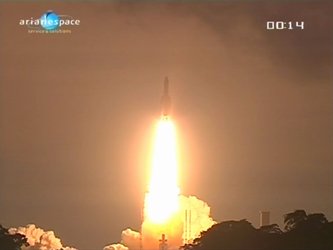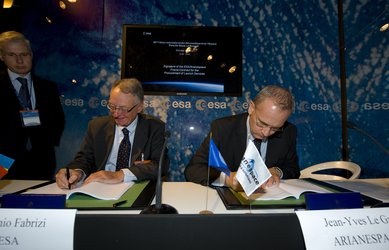Ariane 5’s third launch of 2010
Yesterday evening, an Ariane 5 launcher lifted off from Europe’s Spaceport in French Guiana on its mission to place two telecommunications satellites, Nilesat-201 and Rascom-QAF1R, into geostationary transfer orbits.
Liftoff of flight V196, the 52nd Ariane 5 mission, took place at 22:59 CEST (20:59 GMT; 17:59 French Guiana). The target injection orbit had a perigee altitude of 250 km, an apogee altitude at injection of 35 919 km and an inclination of 2º.
The satellites were accurately injected into their transfer orbits about 28 minutes and 32 minutes after liftoff, respectively.
Nilesat-201 will be positioned in geostationary orbit at an altitude of about 35 800 km over the equator at 7°W and will provide broadband direct-to-home television broadcast services to North Africa and the Middle East in the Ku- and Ka-bands.
Rascom-QAF1R, to be positioned at 2.85°E, will provide communications services in rural parts of Africa, including long-distance domestic and international links, direct TV broadcasts and Internet access. The payload mass for this launch was 7085 kg; the satellite masses totalled 6250 kg, with payload adapters and dispensers making up the additional 835 kg.
Arianespace and Europe’s Spaceport are planning three more Ariane launches in 2010, maintaining the heavy-lift vehicle’s flight rate. The ability to sustain high launch rates has already been demonstrated: during the 12-month period from August 2007 to August 2008 there were nine launches (V177 – V185).
V196 flight timeline
Ariane 5’s cryogenic, liquid-propellant main engine ignited first. Seven seconds later, the solid-propellant boosters also fired, and the vehicle lifted off a fraction of a second later.
The solid-propellant boosters were jettisoned 2 min 23 sec after main engine ignition, and the fairing protecting the payload during the climb through Earth’s atmosphere was discarded at 3 min 29 sec. The launcher’s main engine shut down at 8 min 53 sec; six seconds later, the main cryogenic stage separated from the upper stage and its payload.
Four seconds after main stage separation, the engine of the cryogenic upper stage was ignited to continue the journey. This engine shut down 24 min 43 sec into the flight, at which point the vehicle was travelling at 9437 m/s (33 973 km/h) at an altitude of 556.8 km – and geostationary transfer orbit had been achieved.
At 28 min 46 sec, Nilesat201 separated from the upper stage, followed by Rascom-QAF1R at 32 min 46 sec. Ariane 5’s flight was formally completed 48 min 50 sec after main engine ignition.















 Germany
Germany
 Austria
Austria
 Belgium
Belgium
 Denmark
Denmark
 Spain
Spain
 Estonia
Estonia
 Finland
Finland
 France
France
 Greece
Greece
 Hungary
Hungary
 Ireland
Ireland
 Italy
Italy
 Luxembourg
Luxembourg
 Norway
Norway
 The Netherlands
The Netherlands
 Poland
Poland
 Portugal
Portugal
 Czechia
Czechia
 Romania
Romania
 United Kingdom
United Kingdom
 Slovenia
Slovenia
 Sweden
Sweden
 Switzerland
Switzerland









































